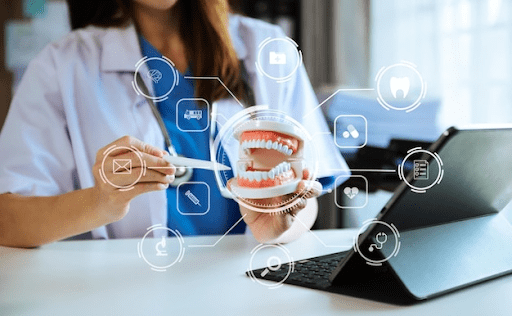Dental Revenue Cycle Management with AI

The financial management of a dental practice is more than excellent clinical care – it is about effective, efficient, accurate revenue cycle management (RCM). The revenue cycle management process encompasses the practice’s insurance verifications, claim submission, and payment collection. RCM is the foundation of a practice’s financial health.
As administrative pressures and payer demands rise, dental teams face increasing pressure. AI in dental revenue cycle management may help in year-over-year collection growth and staff productivity. People are already using AI in healthcare revenue cycle management, and it is estimated to reach up to $180.33 billion by 2034, growing at a CAGR of 24.20% since 2024. The market is driven by the rise in demand for automation in billing, coding and claims processing.
These data highlight the impact of AI, through the automation of tasks such as insurance verification and claims scrubbing that expedite reimbursements and allow team members to focus on patients instead. In this blog, we will look at how AI streamlines dental revenue cycle management.
Introduction to Dental Revenue Cycle Management (RCM)
Dental Revenue Cycle Management (RCM) refers to a procedural system that guarantees efficient, precise, and timely payment of dental practices to their services. This is achieved by linking both clinical and administrative processes to one revenue-generating unit through patient appointment booking to the final payment record.
Dental RCM consists of important elements, such as:
- Patient Registration & Eligibility Verification: Collecting accurate demographic and insurance information ahead of time helps to avoid delays and denials.
- Clinical Documentation & Diagnosis: Comprehensive, clear clinical notes and diagnosis are the basis for coding and claims.
- Treatment Planning & Coding: Accurate procedure code assignments based on diagnosis are an essential part of insurance reimbursement.
- Claims Submission & Tracking: Submit, track, and resolve claims timely and accurately to minimize denials or extended payment cycles.
- Payment Posting & Collections: Systems in place to ensure payments are posted accurately and amounts owed by patients are addressed quickly.
- Audit Readiness & Compliance: Accurate documentation and coding allows for documentation to be utilized in audit defense as well as compliance with payer policies and regulations.
An enhanced revenue cycle management (RCM) process optimizes not only financial performance, but the patient experience as well, eliminating surprises with billing, reducing approval wait times, and fostering streamlined communication between the front office, providers, and payers. With technology such as AI supporting diagnostics and documentation, practices are equipped to improve and elevate each stage of the revenue cycle, creating stronger financial health and sustainability.
Role of AI in Dental Practices
Artificial intelligence is changing the way dental practices handle the revenue cycle, from diagnosis to reimbursement.
As former IBM CEO Ginni Rometty said, “Some people call this artificial intelligence, but the reality is this technology will enhance us. So instead of artificial intelligence, I think we will augment our intelligence.” In a dental practice, this means AI will augment the intelligence and expertise of the front and back office teams, freeing up their time from repetitive, and prone-to-error tasks, so they can focus on patient care and solving complex problems.
Here’s how AI supports smarter RCM:
1. Enhancing Billing Accuracy with AI
Billing and coding accuracy are the basis of a clean claim, a claim that is paid the first time it is submitted.
Manual coding is a frequent bottleneck, which can lead to simple human errors such as using an expired code, failing to include the appropriate documentation (such as X-rays or narratives) or associating a service with an incorrect insurance benefit.
Claim Scrubbing tools are AI-based applications, which scan claims prior to submission. They apply machine learning to match the codes that have been provided, the history of the patient, the payer rules, and the supporting clinical notes to a huge database of successful and rejected claims.
2. Automating Claims Submission
Once they are scrubbed of any errors, claims should be forwarded to the appropriate clearinghouse or payer portal. It is a process that requires a lot of clicking, portal logins, and data entry through various systems.
Robotic Process Automation (RPA) is one form of AI that automates the following steps:
- Preparation: Compiles the certified claim information, attachments and narratives.
- Submission: Logs into the required digital channels (payer portals or clearinghouses) and submits the claim automatically, often in batches.
- Tracking: Instantly starts tracking the claim status, frequently updating the practice system in real-time without calling out manually.
The automation saves the time of the staff, which can be significant. According to one report, AI can save up to 95% of the time that employees devote to cleaning and submitting claims, and the time they could use to interact with patients instead of dealing with paperwork.
3. Reducing Denials and Rejections
A high denial rate is a loss of revenue. The rework cost (time to identify the denial reason, fix the error, resubmit) may be high, and even greater than the claim itself. Moreover, in cases where appeals are made against claims, insurers tend to maintain the initial denial. AI targets the sources of denials:
- Preemptive Error Correction: AI is combined with clinical and billing systems to detect any eligibility problems, absent documentation, or incorrect coding, and prevents claims to leave the office.
- Root Cause Analysis: AI can be used to analyze past trends in claims that were denied to uncover systemic problems so that the management can address workflow or training lapses.
- Pre-authorization Alerts: AI supports the identification of claims in which insurers should conduct pre-authorization before the delay in treatment and payment.
4. AI-Powered Patient Insurance Verification
One of the most time-consuming administrative procedures is manual insurance verification; a staff member calls or logs in to various payer portals to verify benefits. It is also very prone to mistakes that would bring about financial shocks to both the practice and the patient.
Here’s how AI transforms this process:
- Instant Check: AI links to the database of insurance companies based on the name and ID of the patient.
- Full Breakdown: Gives information about the policy, a deductible, and the amount that will still be in the policy after a year, and the percentage of coverage.
- Clear Estimates: AI will give the final out of pocket cost estimate prior to treatment.
- Less Denials: AI identifies errors and ensures that coverage is confirmed at the beginning eliminating rejections and accelerating faster payment.
5. Improving Revenue Collection and Cash Flow
The administrative efficiencies of AI will have a direct and positive influence on the financial health of the practice.
- Reduces Days Sales Outstanding (DSO): Through timely submission of clean claims and minimizing the amount of work, AI lowers Days Sales Outstanding (DSO) – the average number of days required to collect revenue following the delivery of a service. There is also increased collection of patient-responsible balances because of faster verification and open financial discussions.
- Text-to-Pay Feature: AI can also facilitate this by automating the system to remind patients of their payments and by providing an option to pay digitally, i.e. the Text-to-Pay feature, thus making it easier to pay.
- Automated Payment Posting: AI systems can automatically read Electronic Remittance Advice (ERAs) or even scanned Explanation of Benefits (EOBs) and make payments correctly to the appropriate patient accounts in the Practice Management System (PMS) in less time and with zero errors.
Benefits of Integrating AI into Dental RCM
AI implementation in dental RCM operations is not only efficient but also potentially leads to improved patient care. This is where applying AI in RCM can go beyond financial performance, enhancing the overall health of the organization and the patient experience:
| Category | Advantage | Impact |
| Financial Performance | Increased Clean Claim Rate | Reduction in claim denials by up to 20% |
| Optimized Reimbursement | Minimized under-coding and lost revenue | |
| Accelerated Cash Flow | Reduces Days Sales Outstanding (DSO) | |
| Patient Experience | Financial Transparency | Improved case acceptance and patient trust |
| Faster Service | Patients move through check-in and treatment faster | |
| Staff Efficiency | Improved Focus | Staff may focus on patient care and scheduling |
| Reduced Administrative Workload | Cuts manual verification time by up to 70% | |
| Compliance & Risk | Consistent Adherence to Payer Rules | Reduces risk of audits and penalties from claim errors |
Conclusion
The complexity of dental insurance and administrative work is posing a challenge to modern dental practices. Financial stability and operational excellence can be ensured through Artificial Intelligence, which involves automating repetitive processes, enhancing billing accuracy, and avoiding revenue loss.
AI-driven RCM empowers dentists and hygienists with more intelligent resources, enabling them to do their work and deliver outstanding patient care.
Do you continue to lose valuable revenue to avoidable denials and administrative backlog in your practice? Get a step further towards the future of your practice! Contact CEComputech, the provider of AI RCM solutions, today to have a demo of how intelligent automation can change your cash flow, increase your clean claim rate, and liberate your staff to focus on what matters the most: your patients.





